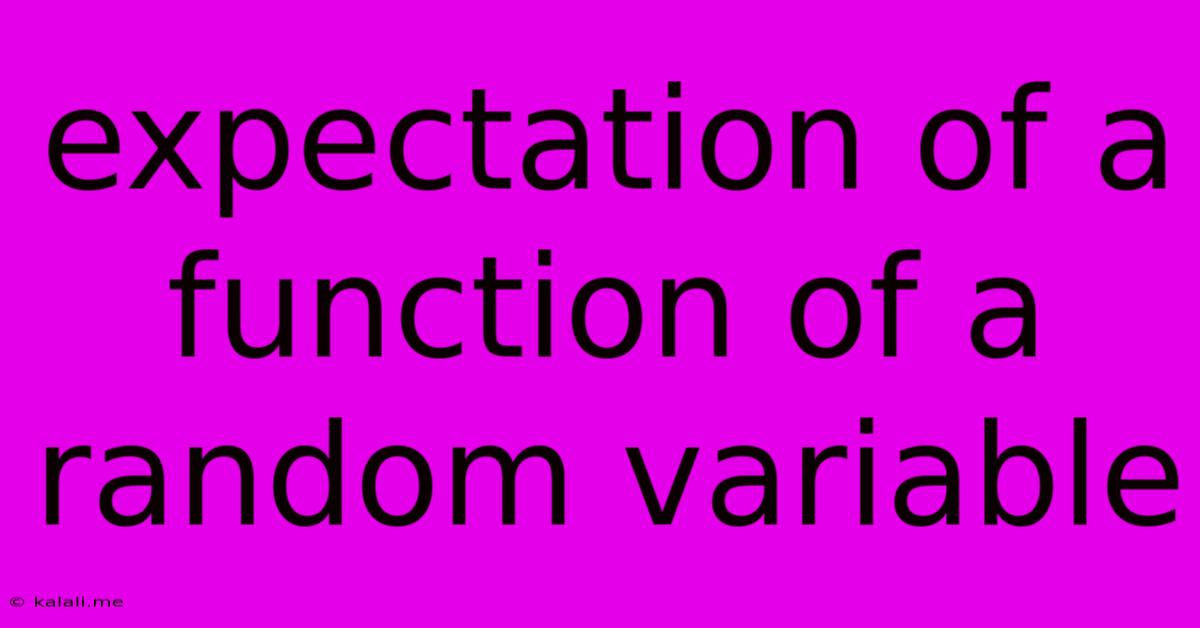Expectation Of A Function Of A Random Variable
Kalali
Jun 04, 2025 · 3 min read

Table of Contents
Understanding the Expectation of a Function of a Random Variable
This article explores the concept of the expectation of a function of a random variable, a crucial topic in probability and statistics. Understanding this allows us to analyze and predict the behavior of various transformations of random variables, which has broad applications in fields like finance, engineering, and machine learning. We'll delve into the definition, key properties, and practical examples to solidify your understanding.
What is a Random Variable?
Before diving into the expectation of a function, let's briefly revisit the concept of a random variable. A random variable is a variable whose value is a numerical outcome of a random phenomenon. For instance, the outcome of rolling a die is a random variable, as is the height of a randomly selected person. Random variables can be discrete (taking on a finite or countably infinite number of values) or continuous (taking on any value within a given range).
Expectation of a Random Variable (E[X])
The expectation, or expected value, of a random variable X, denoted as E[X], represents the average value of X over many independent trials. For a discrete random variable, it's calculated as the sum of each possible value multiplied by its probability:
E[X] = Σ [x * P(X = x)]
For a continuous random variable with probability density function f(x), the expectation is calculated as an integral:
E[X] = ∫ x * f(x) dx
Expectation of a Function of a Random Variable (E[g(X)])
Now, let's consider a function of a random variable, denoted as g(X). This means we're applying a transformation to the random variable. The expectation of this function, E[g(X)], represents the average value of the transformed variable g(X).
The calculation of E[g(X)] depends on whether X is discrete or continuous.
- Discrete Case:
E[g(X)] = Σ [g(x) * P(X = x)]
- Continuous Case:
E[g(X)] = ∫ g(x) * f(x) dx
Key Properties of Expectation
The expectation operator possesses several valuable properties that simplify calculations and analysis:
-
Linearity: E[aX + b] = aE[X] + b, where 'a' and 'b' are constants. This means the expectation of a linear transformation is simply the linear transformation of the expectation.
-
Non-linearity (Generally): E[g(X)] ≠ g(E[X]) unless g(x) is a linear function. This is a crucial point to remember. The expectation of a function is not generally equal to the function of the expectation.
-
Additivity: E[X + Y] = E[X] + E[Y], where X and Y are random variables. This holds true even if X and Y are not independent.
-
Multiplicativity (for independent variables): E[XY] = E[X]E[Y] if X and Y are independent. This property does not hold if X and Y are dependent.
Examples
Let's illustrate with a couple of examples:
Example 1: Discrete Random Variable
Suppose X is a discrete random variable representing the outcome of rolling a fair six-sided die. The probability of each outcome is 1/6. Let's find E[X²].
E[X²] = Σ [x² * P(X = x)] = (1² * 1/6) + (2² * 1/6) + (3² * 1/6) + (4² * 1/6) + (5² * 1/6) + (6² * 1/6) = 91/6 ≈ 15.17
Notice that E[X²] ≠ (E[X])² = (3.5)² = 12.25. This highlights the non-linearity property mentioned earlier.
Example 2: Continuous Random Variable
Consider a continuous random variable X with a uniform distribution between 0 and 1 (f(x) = 1 for 0 ≤ x ≤ 1, and 0 otherwise). Let's find E[X³].
E[X³] = ∫₀¹ x³ * 1 dx = [x⁴/4]₀¹ = 1/4 = 0.25
Conclusion
The expectation of a function of a random variable is a fundamental concept with broad applications in probability and statistics. Understanding its definition, properties, and calculation methods is essential for analyzing and modeling various real-world phenomena involving uncertainty. Mastering this concept provides a robust foundation for further studies in more advanced statistical topics. Remember to carefully consider whether your random variable is discrete or continuous when applying the appropriate formula.
Latest Posts
Latest Posts
-
Symptoms Of Bad Hot Water Heater Element
Jun 06, 2025
-
Baking Soda Is Base Or Acid
Jun 06, 2025
-
Albert Einstein Blind Belief In Authority
Jun 06, 2025
-
Jezebel In The Book Of Revelation
Jun 06, 2025
-
Navigate To Another Component On Initialization Using Urladdressable
Jun 06, 2025
Related Post
Thank you for visiting our website which covers about Expectation Of A Function Of A Random Variable . We hope the information provided has been useful to you. Feel free to contact us if you have any questions or need further assistance. See you next time and don't miss to bookmark.